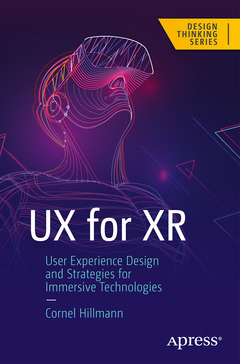Description
UX for XR, 1st ed.
User Experience Design and Strategies for Immersive Technologies
Design Thinking Series
Author: Hillmann Cornel
Language: English
Approximative price 36.91 €
In Print (Delivery period: 15 days).
Add to cart
Publication date: 06-2021
255 p. · 15.5x23.5 cm · Paperback
255 p. · 15.5x23.5 cm · Paperback
Description
/li>Contents
/li>Biography
/li>Comment
/li>
Extending traditional digital platforms to the new frontier of extended reality (XR) requires taking into account what best practices, new concepts, and conventions have been established and what learnings can be brought forward from case studies involving industry leaders. By looking at practical examples from the field of handheld AR breakthroughs, virtual reality (VR) success stories and experimental interaction concept of pioneering XR platforms, you'll see how it's possible to map out a framework of user experience (UX) guidelines to close in on opportunities and challenges that lay ahead.
This book defines, identifies, and analyzes UX practices for XR environments and reviews the techniques and tools for prototyping and designing XR user interactions. You'll approach the design for experiential state and spatial cognition, using established UX key performance indicators, while taking into account the social dynamics, emotional framework and wider industry context.
UX design and strategy for the XR space is a new frontier, so UX for XR focuses on case studies and industry research to illustrate the relationship between UX design and the growth of immersive technologies. Practical examples will demonstrate how you should apply UX design principles using designing interactions in XR by identifying the importance of spaces, senses and storyboarding.
What You'll Learn
- Explore the challenges and opportunities of designing for XR
- See how spatial interaction is revolutionizing human computer interaction
- Examine sensory input and interaction beyond the screen
- Work with 3D Interaction Design and build a strong 3D UX
- Understand VR and augmented reality essentials for emotion-rich user experiences
- Apply UX research techniques for the XR space
Who This Book Is For
This book is primarily for UX designers, consultants, and strategists; XR developers; and media professionals
Chapter 1: The history and future of XR
- 1.1 XR: From early experiments to the fourth transformation
- 1.2 VR: A rollercoaster ride into the future
- 1.3 AR: Handheld AR success stories, prototypes and the AR cloud
- 1.4 A new era of XR gamification: UX and user engagement
Chapter 2: The rise of UX and how it drives XR user adoption- 2.1 UX and the macroeconomics of the next big thing
- 2.2 Key lessons from three decades of VR experiences
- 2.3 User agency and storytelling
- 2.4 HCI, usability and UX
Chapter 3: UX and experience design: From screen to space
- 3.1 Creative solutions for the XR friction funnel
- 3.2 The fundamentals of designing spatial experiences
- 3.3 Immersive interaction: Senses, haptics, gestures, audio and voice
- 3.4 XR and mindful design
Chapter 4: Pioneering platforms and UX learnings
- 4.1 Handheld AR breakthroughs
- 4.2 VR: The Oculus ecosystem
- 4.3 Magic Leap and Microsoft Hololens: Entertain, inform, assist and inspire
- 4.4 VR, AR, MR: The evolution of prototypes
Chapter 5: Practical approaches: XR UX in the real world
- 5.1 Tools and techniques for prototyping
- 5.2 Narrative mechanics, UI, 3D personas and story flow
- 5.3 UX Strategy, analytics and data acquisition
- 5.4 Effective UX audits for XR projects
Cornel Hillmann is a media designer and CG artist with over 20 years of experience in the media and entertainment, advertising and design industry. He has worked with brands including Panasonic, Jaguar, The Future is Wild, The Singapore International Film Festival, Razor and many others. Cornel has lectured masterclasses for immersive media post-production, advanced 3D-, VR- and media design-courses at Limkokwing University and is the author of “Unreal for Mobile and Standalone VR” (Apress, 2019).
Highlights the new challenges and opportunities for UX designers with XR, VR, and AR
Provides a historical perspective of the UX industry and analyzes how the design paradigm shift will shape the future
Examines the major UX and XR technologies and tools such as Apple’s ArKit, Google’s ARCore and Facebook’s Oculus platform
© 2024 LAVOISIER S.A.S.




